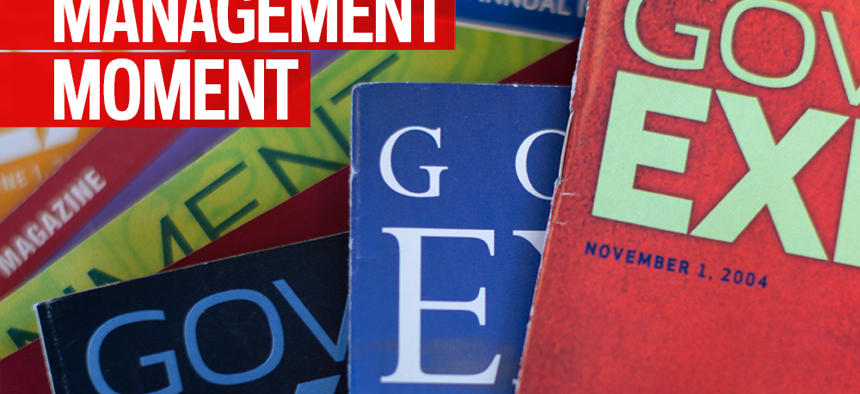
Partial Quality Management
What we were saying 20 years ago about improving government performance.
From the archives of Government Executive...
April 1994—It has been almost five years since government began the push for total quality management and continuous improvement. Since then, agencies have spent millions of dollars studying just how to do it, and millions more setting up their systems.
There is no doubt that TQM has yielded results, whether at the headquarters level—the Department of Defense and Internal Revenue Service have both mad solid improvements—or in the field. Here in Minnesota, for example, the field servicing office of the Agriculture Department’s Animal and Plant Health Inspection Service (APHIS) has generated real gains in timeliness and service through a TQM effort designed with help from the 3M Co.
Yet, as government begins the quality management “basic training” for all employees that the National Performance Review report recommends, it must confront the barriers that have plagued past improvement efforts. In the spirit of quality guru W. Edwards Deming’s 14 Points and the other lists of helpful hints that characterize TQM training, consider Four Fatal Frustrations that must be resolved if TQM is to have staying power as a reform tool.
Who is the Customer Anyway?
Many agencies have been unable to identify who their customers are and haven’t known how to serve them once they’ve been identified. There is certainly nothing wrong with trying to become more user-friendly. The more serious problem comes when agencies such as the Environmental Protection Agency or the Forest Service are asked to serve one set of customers today, while protecting another far out into the future. These “stewardship” agencies can get much better at delivering services quickly and with a smile, but they may find themselves unable to satisfy today’s customers without denying tomorrow’s.
Constancy or Confusion?
Government seems unable to achieve the “constancy of purpose” that Deming listed as the first of his 14 Points. TQM was simply added on top of everything else federal managers were asked to do.

Federal agencies and their managers can hardly be blamed if they wait for this reform, too, to pass. Twenty-five years ago, it was the planning, programming and budgeting system. Twenty years ago, the Inspectors General. Fifteen, pay for performance. Ten, Reform ’88. Five, TQM. Today, it is a performance budgeting system that looks mighty similar to the old planning, programming and budgeting. Like sediment at the mouth of a river, these reforms have been added on top of each other without the old ever being dredged out.
Beyond this turnover of reforms, consider also the turnover of appointees. If past patterns hold, the Clinton Administration will replace roughly a third of its political leadership by June, and fully half by next January. TQM cannot be just the province of the career workforce.
How Fast Do the Savings Come In?
TQM cannot promise fast results or deep savings. In fact, TQM may cost money—for new equipment, better training and, dare one suggest, more front-line staff. Further, most TQM efforts take 7 to 10 years to provide payoffs. Yet, government all too often demands results in three years. What is remarkable about TQM efforts at the IRS, DoD and APHIS is not that they have produced results, but that they were able to keep their momentum. They have persevered despite persistent barriers to success.
For a small operation like the APHIS field servicing office, the barriers are doubly frustrating. The office was given no relief from personnel rules to create more room for team-building, no budget reform to carry over resources from year to year and no deregulation to free employees from mind-numbing paperwork. TQM is no easy process to begin with. It involves great commitment and energy. But it cannot be sustained without structural reform of the kind envisioned in the NPR report. Unfortunately, TQM in government is too often nothing more than exhortation and slogans. After two or three years, the employees figure that out and go back to business as usual.
Front-Line Empowerment, or Mid-Level Bulge?
TQM in government can create bureaucratic growth industries of its own, sometimes becoming a justification for positions and layers that do more harm than good. As middle managers get flattened out of their old jobs as cross-checkers and micro-processors, they may adopt TQM as their new raison d’etre .
In theory, TQM should be a virtually invisible part of the ordinary day, a natural way of thinking and doing. In practice, TQM in government can become an extraordinary bureaucratic system teetering under its own weight, a process nightmare. Meeting after meeting, training session after training session, a ton of paperwork and measurement. No federal employee has yet been TQMed to death, but thousands would likely swear they have come close.
Along the way, Deming’s 14 Points have been whittled down by political reality. Everyone still loves a scandal, so his point about “driving out fear [of mistakes]” is struck from the list. Congress won’t change the merit pay system, so his point about eliminating individual performance appraisals goes. Political appointees won’t stay put, so there goes stability of leadership. Check off all the exemptions for government, and the 14 Points look more like three or four. TQM is no longer a way of being, but an occasional afterthought; no longer a system, but an infrequent call to arms.
These Four Fatal Frustrations can be tempered by setting realistic expectations about what TQM can and cannot do for government (it cannot, for example, substitute for careful policy planning upstream in Congress and the White House) and by preventing its capture by middle-level managers in search of new work.
Still, the future of TQM, indeed of any customer-driven reform, is clouded by one simple question: Is “customer” the right word to use in describing citizens? For decades, to be sure, citizens have been treated as less than customers. They were labeled “clients” or, worse yet, “targets”—units to be serviced by government analysis and engineers. The citizen was presented as a set of problems, often to be addressed by different agencies at different locations at different points in time (hence, the Vice President’s horror story about the very different ways government agencies value assets in determining welfare benefits).
Redefining citizens as customers is no doubt a step in the right direction. It weakens the “government-knows-best” mentality that cuts into civic confidence. For the time being, however, most citizens cannot exercise any real power as customers of government. They cannot choose between Crest and Colgate, Campbell’s Soup or Progresso, Dodge or Toyota. They are usually offered one brand, and one brand only, then asked how it could be improved.
TQM may also feed on an overly generous image of the brand-loyal, courteous, well-informed customers that Macy’s would love to have. Anyone who has worked in retail knows that all customers are not created equal, nor do they all behave the same way. Some have more money than others, others have more information, still others have better access.
Marketers also know that customers do not always behave the same way in every setting—think of Macy’s the day after Thanksgiving—nor do they use the same decision-making process on every product. The choice of toothpaste or toilet paper, for example, is more likely to depend on price and shelf placement than on brand loyalty, while the choice of a car or other durable good is more likely to turn on questions of performance.
Ironically, one way to cultivate this better customer is to stop treating citizens as customers altogether. The fact is, sometimes citizens are co-producers, creating value alongside government; sometimes they are catalysts, creating value before government; and most certainly they are problem solvers, creating value in lieu of government.
Government needs to ask whether its customers need to be customers at all—that is, whether they can solve problems on their own. That is something few, if any, private firms ask. Their interest, after all, is in keeping their customers. The government must never do for citizens what they can do for themselves.
Indeed, giving citizens a fuller stake may be the key to keeping agencies lean and fit. As customers, citizens can’t be expected to care much about how tall, wide or rule-bound government is—they set their expectations by past performance, then act as passive receptors. But as co-producers, catalysts and problem-solvers, they care very much about bureaucracy: It limits their access and influence.
As America proceeds with reinventing government, it might consider reinventing citizenship, too. That’s an idea already brewing with Bill Galson, White House domestic policy aide, and Harry Boyte here at the Humphrey Institute. In the search for a metaphor that asks citizens to take a greater role in governing themselves, thinking of citizens as citizens might be just what government needs.
In 1994, Paul Light was a professor at the University of Minnesota’s Hubert H. Humphrey Institute of Public Affairs, a senior fellow of the Governance Institute and a visiting fellow of the Brookings Institution.







